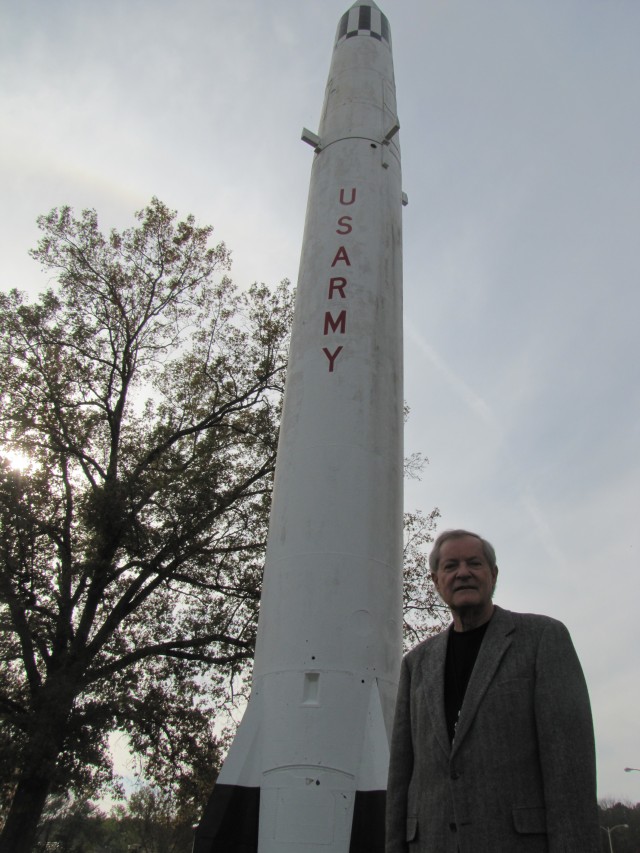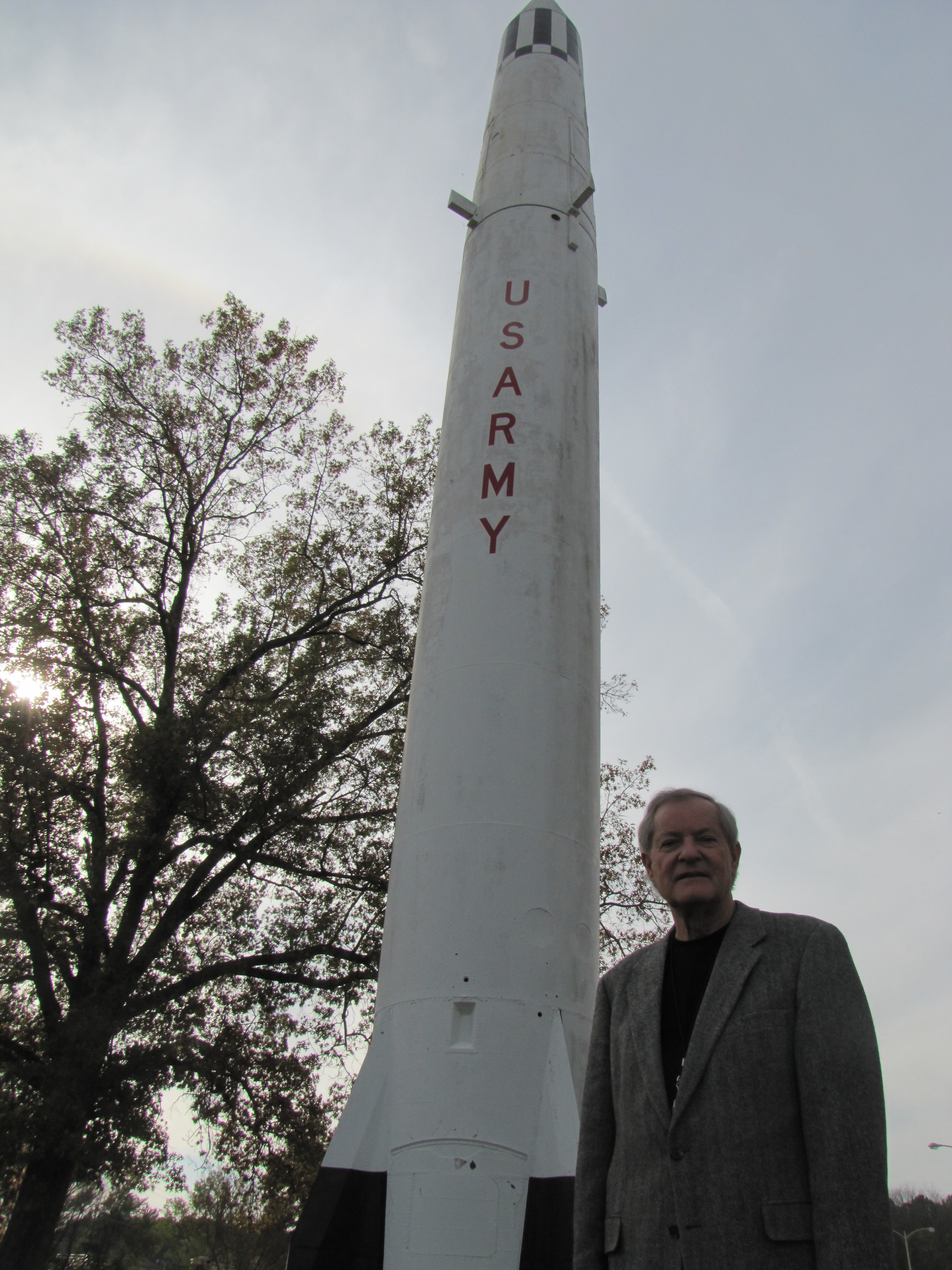
REDSTONE ARSENAL, Ala. -- Peenemunde was a practice test.
It was a practice test for the real thing - Redstone Arsenal.
Today, more than 60 years after Dr. Wernher von Braun and the German rocket team left the isolated and guarded 50,000-acre military post in northeastern Germany, most of the evidence of Peenemunde - its laboratories, test stands, factories, living quarters, roads and infrastructure -- is gone.
But for Ed Buckbee, a picture that superimposed the Peenemunde of the early 1940s over the now overgrown, forested and abandoned German military base showed to him the parallels between the technology center where the Germans launched the first rocket into space and the North Alabama home of the beginnings of the U.S. space program.
"My visit to Peenemunde brought home to me that Wernher von Braun, in his late 20s, erected this immense technology center in the northeastern part of Germany, in the woods," Buckbee said. "I had no idea of the extent of the technology that was created at that facility.
"Wernher von Braun and his team conceived, designed, fabricated, tested and launched an entirely new missile system from the Peenemunde site and then they repeated that at Redstone Arsenal. The Army system of missile development that we experienced in the '50s was created first at Peenemunde by von Braun and his team."
Buckbee began his association with the German rocket scientists in 1959 when, as a young Soldier, he was assigned to the personnel office at Redstone. He went on to work in NASA public affairs with von Braun, and then became the first director of the U.S. Space & Rocket Center. His association with von Braun often gave him access to private times when von Braun would talk about the early years of rocket development. Buckbee's trip to Peenemunde in September with a group from Huntsville filled "a missing part of my von Braun knowledge."
______________________________________________________________________________
Space Beginnings
Part 4 in series
______________________________________________________________________________
Today, the German people have two schools of thought on Peenemunde - the older generation often express their appreciation for what von Braun accomplished while younger Germans are ashamed of von Braun's association with the Third Reich, Buckbee said.
"I would tell them they need to look beyond the conflict of their country," he said. "The technology developed on the site of Peenemunde allowed two nations to explore space for peaceful purposes. It has allowed the U.S. and then the U.S.S.R. to begin space exploration that continues today and now includes nations like China and India.
"That is a contribution that Germany has made and that continues to be valued by history. Germans are missing the opportunity to share that story with the world. There's an amazing amount of technology developed in the '30s and '40s by Germans that we're still using today. We haven't advanced that much further from that basic technology."
Peenemunde represented a place where the German rocket team could develop rocket technology. It was an exciting time for scientists who had "finally gotten a government contract with serious money to develop rockets."
When von Braun and his rocket team first arrived at Peenemunde, the location became a "technology settlement they had created where they had all the capability of developing systems. In the late '30s and early '40s, the location allowed them to focus on the advancement of technology," Buckbee said.
At the time, the German rocket team was young, very aggressive in their work, and willing and able to spend long hours - 16 and 18 hour days - working on rocket development. The team members lived only a short distance from where they worked. They were isolated from the political, social and military climate of the German nation.
"It was a small group of people who worked and lived together, and their work was all about launching rockets for exploration," Buckbee said. "They all enjoyed those early years there. They were not monitored closely. It was a great time for exploring. The V-2 captured information at a high altitude that helped them learn about the performance of rockets.
"Then the army completely took over. And they were required to make missiles. That is not what they expected the V-2 to be doing. They were not really expecting to be thrown into a war-like effort."
When von Braun was arrested by the SS in March 1944, things changed dramatically for the German rocket team. Von Braun was imprisoned for declaring his main interest in developing the V-2 was for space travel, not as a weapon.
"He thought his life was over. He thought he would be executed because someone had planted documents in his (government-provided) airplane and they thought he was going to escape to the U.K. with all the documents for rocket technology," Buckbee said. "If it hadn't been for (Peenemunde commander Walther) Dornberger coming to his defense, he would have been executed."
Then, as the war was ending von Braun and his team quietly began making plans to leave Germany. They did not want to live under a second dictatorship. The team voted and made up their mind to go to the U.S.
"They got out of Peenemunde with all documentation and about 100 V-2s," Buckbee said. "At the end of the war, they feared they would either be executed by their own army or that they would be captured by the Russians. They had to execute a plan of surrender to the allied forces. Somehow they were able to get out with equipment, hardware and documentation before the transportation system collapsed and the troops came.
"Fortunately, Maj. Gen. Holger Toftoy recognized what was coming to us."
In the U.S., first at White Sands, N.M., and Fort Bliss, Texas, and then, finally, settled in at Redstone Arsenal, the German rocket scientists were once again teamed with a military program.
The parallels between Peenemunde and Redstone Arsenal are numerous. First, both are large sites
that at one time were isolated and had to be built up to manage rocket development. At both sites, the military - first the German army and then the U.S. Army - drafted Soldiers with technical backgrounds to be taught by the German scientists and to work in support of rocket development. And then, in both instances, the German rocket team found themselves becoming a political pawn - in Germany their work shifted from civilian rocket development to military missile development while at Redstone their work went from developing missiles for the Army to working on the nation's new space program.
While part of the Army, the German rocket team began to grow American missile technology, building a German and American team of engineers that gave the U.S. strength in dealing with the Russians.
"A lot of things accomplished in the '50s were not credited to Redstone and von Braun's team. There were a lot of important missile accomplishments that came out of the work done here in the '50s," Buckbee said.
"The German-born rocket scientist is the guy who made it possible for Americans to go to the moon and beat the Russians. Americans like me and my generation were mentored and taught by Germans about rockets and space travel."
Their Army work culminated with Explorer I, putting America's first satellite in space. Soon after that, the Army Ballistic Missile Agency transferred its space efforts to the newly formed NASA and Marshall Space Flight Center.
"They were comfortable here with the Army. The loyalty and dedication they had to the U.S. Army was very deep," Buckbee said. "They were indebted to the U.S. Army.
"It was a tough decision to go to NASA. They were leaving an organization that enabled them to come here. They were leaving the organization of Toftoy and (Maj. Gen. John) Medaris, leaders who allowed them to develop rocket technology for 10 years before going to NASA. The work they did for the Army laid the foundation for the missile defense that we're still using today. Our strength grew with the von Braun team."
In his job with Army personnel, Buckbee was in the thick of the transfers from the Army to NASA.
"There was a huge uproar over the transfer," he said. "It was not a pleasant time for military personnel because they were seeing their whole organization (the Army Ballistic Missile Agency) coming apart. Some 3,000 to 4,000 people left ABMA. Most of my friends began resigning their commissions and were being offered jobs by NASA."
As the NASA team of American scientists expanded, the German rocket team excelled in their roles as mentors and teachers.
"We didn't have the knowledge. We went to the moon with German brainpower, American ingenuity and national pride," Buckbee said. "They taught us the basic principles of rocketry. The Germans ran all the labs back then. The American engineers worked right beside them and eventually they became the directors. The mentoring and teaching the German rocket team offered us was amazing."
In his job at NASA, Buckbee did speech and television script writing for von Braun. He often traveled with the German scientist. Eventually, Buckbee was charged with collecting hardware for what would later be the U.S. Space & Rocket Center. The center opened in 1970, and von Braun often visited the museum.
"He came up with the idea for Space Camp," Buckbee said. "It was the 1975 time frame and everyone was doing camps. He had done a lot of work with Walt Disney. And he thought the Space & Rocket Center should have a space camp. He was very interested in reaching out to youth and engaging the next generation, and getting them excited about space and making a contribution in the future."
Von Braun died in 1977, but the space mission he started continues today.
"All these future projects - today's space station, and moon bases and travel to Mars - he had them all on his desk," Buckbee said. "He really was a man for tomorrow, a crusader for space flight always focused on the future. He was never satisfied with the accomplishments of today. He always believed man's reach should exceed his grasp."
The lessons of those early years still remain with Buckbee - lessons about having a "can do attitude," keeping an "open door" policy, finding accomplishments even in failures, encouraging competition among organizations for the best solutions, focusing on shaping public opinion and communicating with your team. And he still remembers the von Braun phrase - "Let me remind you, you are on a critical path" - that kept the nation's space scientists focused and moving forward.
"Von Braun used one-page weekly notes to communicate. His scientists would provide the notes and von Braun would write in the margins and send them back," Buckbee said. "There are 10,000 weekly notes collected from 1961 to 1969.
"Von Braun was a communicator at the maximum level. If he were alive today, he'd be texting and doing Facebook. He'd be communicating."
Von Braun's vision, the knowledge of the German rocket scientists, and the team of Germans and Americans that made space exploration a reality first while with the Army and then with
NASA "still makes us the only country to launch a human out of Earth's orbit and we did that nine times with the Saturn rocket," Buckbee said. "The older I get, the more I appreciate it."

Social Sharing